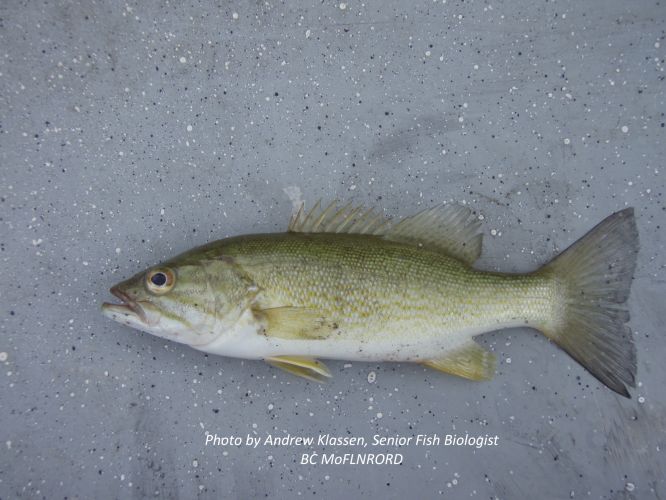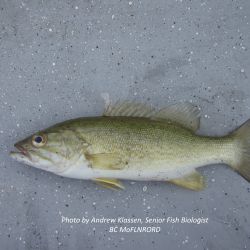
Priority: Prevent
General: North American native, large, deep-bodied fish that has become invasive in BC due to intentional introductions for sport fishing.
Size: 25-40cm long
Colour: White on the bottom or belly, grey-green on the back side and lighter on the sides with vertical dark bands.
Special Features: It has a small mouth that extends just below the eye. Two dorsal (on its back) fins fused together. The front of the dorsal fin has spines and the back of the same fin has soft rays. It has a flat, oval-shaped body.
Largemouthed Bass (Micropterus salmoides)
Differences: The main difference between the Largemouthed and Smallmouthed Bass is mouth size and patterns on the sides of their body. The Largemouth Bass have a dark horizontal line running from their gills to the tail. The mouth extends past the center of its eye.
Where did it come from? Smallmouth Bass are naturally found in central and eastern North America: from the Great Lakes in Quebec to central Texas.
Where does it live here? They prefer reservoirs, ponds, rivers and streams. They like clear waters of what is called the littoral zone with gravel bottom and little or no vegetation. They like to be under logs or docks. In the winter, they move to deeper waters and are dormant. When it is warmer, they feed and spawn in shallower, warmer water. They are found on Vancouver Island, Okanagan, Thompson, Cariboo and Kootenay areas in BC.
Reproduction: Females lay 1000’s of eggs and spawn several times in a season.
When does it reproduce & mature? Spawning time is dependent on a number of factors including water temperature. Spawning can occur as late as June-July. A Smallmouth Bass reaches sexual maturity in the 2-4th year in the northern areas.
Spreads By: Introduction into lakes for sport fishing. They have also been introduced by live bait and releases from aquarium and garden ponds.
Species Type: Fish
- Feeds on a wide variety of prey including amphibians, insects, small fish and birds. This allows them to invade a variety of habitats.
- Feed on juvenile salmon. This can threaten cultural, recreational and commercial fisheries.
- They can cause a decrease of native species in a waterbody.
- Carry parasites that are harmful to native fish species.
- REPORT all sightings.
- Clean,Drain,Dry your boat, trailer & fishing gear. Dispose of bait in sealed containers.
- Don’t Let it Loose: Don’t let any Smallmouth Bass loose or transfer between lakes in BC. Do not purchase or release aquarium fish into wild lakes, streams etc.
Contact LRISS for specific information or links to experts.
BC Government. Invasive Species Alert! Smallmouth Bass (Micropterus dolomieu).
Brown, T.G., Runciman B., Pollard, S., Grant, A.D.A., and Bradford, M.J. 2009. Biological synopsis of smallmouth bass (Micropterus dolomieu). Can. Manuscr. Rep. Fish. Aquat. Sci. 2887: v + 50 p.
